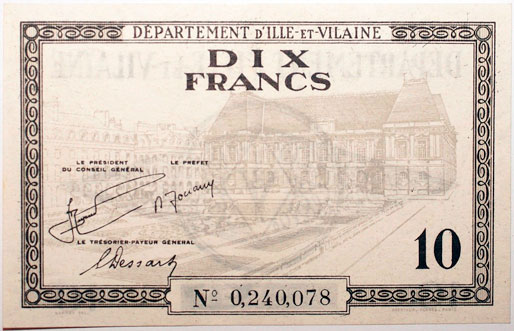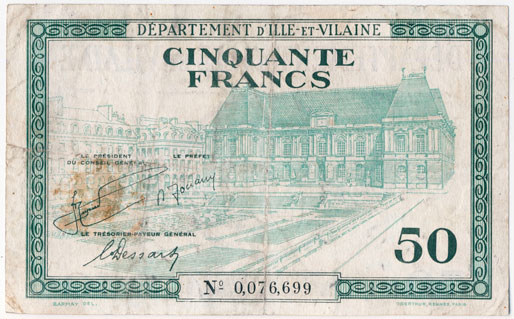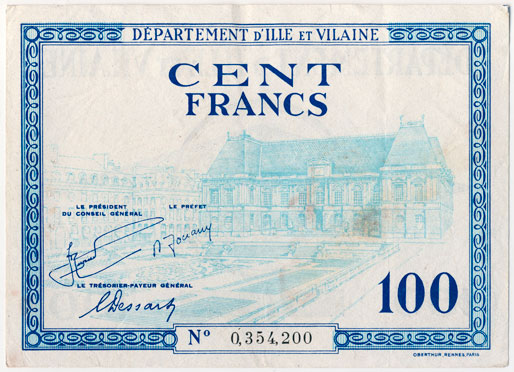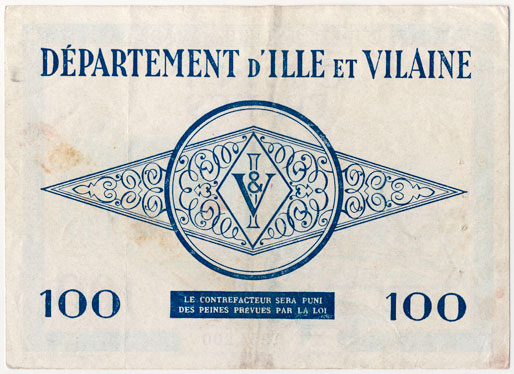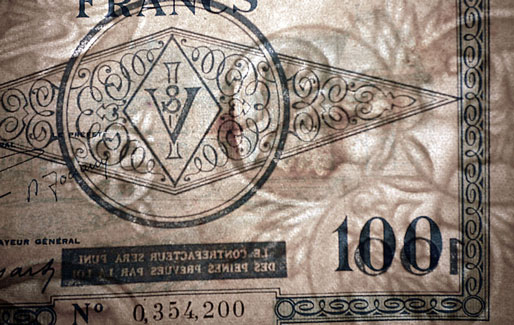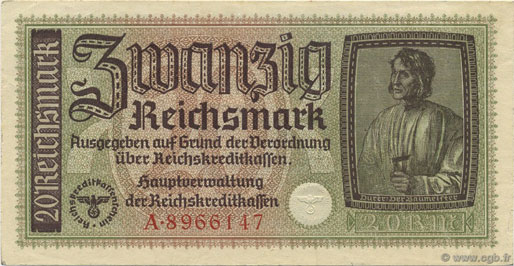SIX EMERGENCY ISSUES BANKNOTES FOR THE DEPARTMENT OF ILLE-ET-VILAINE IN JUNE 1940
HISTORICAL CONTEXT
The German armies invaded Poland on September 1, 1939. France declares war on Germany on September 3, 1939. On May 10, 1940, the Wehrmacht rapidly invades the Benelux countries and a large part of France. Paris was taken June 13, Cherbourg, Brest and Nantes fall June 19. The urgency threw millions of people on the roads, but soon overtaken by the enemy, people are going back home. This mass exodus and suddenly deeply disrupts the country. Cities are crowded with refugees and French military. All banks closed and the balances are moved in emergency in the south, some banknote stocks are even destroyed. The species monetary shortage begins to affect the local economy. To allow the State and communities to continue their commitments to the French, cities and chambers of commerce jointly emit "Emergency banknotes" dated June or July 1940, as in Romilly-sur-Seine, Colmar, Mulhouse, Nantes and Rennes. For the three departments located north of the Loire (Côtes-du-Nord, Ille-et-Vilaine, Lower Loire), are the prefects who personally take the initiative to set emission organizations.
THE CREATION OF A LOCAL CURRENCY IN RENNES
The city of Rennes is occupied from 18 June 1940 by the German army. The newspaper "L'Ouest-Eclair" interrupted his release the next day, June 19, 1940. But under the leadership of the Prefect Jouany and a group of newspaper editors, appears the "Bulletin d'informations d'Ille-et-Vilaine". Despite the censorship, the objective is to enable people without news, to access essential information necessary for the proper continuity of the local public and economic life. The bulletin announcement in its nuber # 3 of 30 June, the creation of a local currency in the department of Ille-et-Vilaine. See the complete article: Here.
The new banknotes 20, 50, 100 and 500 francs are presented on page 2 by the Paymaster General of Ille-et-Vilaine, Mr. Dessart in an interview. Here are some extracts: "The closure of offices branch Bank of France Ille-et-Vilaine has jeopardized the supply of funds for public Banks, the Credit institutions and various organizations whose cash flow was driven through them. Transactions could not be performed since June 19, by means of own resources of various funds. These, including the General Treasury, remained open and carried out all urgent and necessary payments. But their resources are running out and, in a certain period of time, they would have disappeared if, to deal with a situation whose persistence would have resulted in the suspension of transactions with all its serious consequences, it was decided to create in Ille-et-Vilaine a local currency. A notice posted up in all localities informed the public of this issue. ENJOY THE NEW CURRENCY OF THE SAME POWERS THAT TICKETS BANK OF FRANCE; IT HAS THE SAME POWER GENERAL discharge. UNDER THE DEPARTMENT, INDIVIDUALS SHOULD THEREFORE THE RECEIVING PAYMENT WILL LIKE THEMSELVES THE BANKS PUBLIC AND THOSE OF ALL INSTITUTIONS. The introduction of the new currency not only to perform the State's commitments and public authorities, but also to ensure the payment of private salaries. Each one can be certain, now, that monetary transactions remain normal and that the local economy will continue to function in the best general and particular interests."
THE SIX TYPES OF NOTES
In total, the series includes 6 banknotes (1) but the article does not have the two small notes of 5 and 10 francs. On the front of each banknote is shown in a frame, the Palace of the Parliament of Brittany and his garden, after a drawing of Barmay burner with three signatures Jouany, Rupied and Dessart left. Six different colors used to differentiate the denominations (2). The reverse side is the same for each cut. Printing was conducted by Oberthur Rennes printing on paper identical to that used for the titles of Government Annuities. Filigree, medallion we can see the profiles of three ancient deities Republic, Minerva and Mercury. None of the banknotes includes date, but this issue are probably came into traffic on July 1st , 1940 for a repayment deadline of October 31, 1940.
CONCLUSION
This emergency program, like all of the time, at the initiative of courageous leaders, will not face a short life and will not prevent the country from sinking inexorably in the economic and monetary chaos. First the occupier who methodically impose its war machine and its Reichskreditkassen (3) to get its hands on all national resources. Then with the "normalization" of the occupation, the Vichy regime quickly remove what appears to him illegitimate, that is to say, the Emergency Notes from June 1940 and the German currencies, but the Pétain Government eventually succeed to restore a semblance of monetary sovereignty. Finally, the development imposed bank money, then rationing and barter and the black market (4) eventually completed the value of franc (5).
Notes:
(1) Maurice Kolsky, "Les billets de juin 1940", Collection "History of French paper money", p.57 to 59.
(2) 5 frs = yellow hue, 10 frs = black color, 20 frs = pink hue, 50 frs = green tint, 100 frs = blue tint, 500 frs = brown tint.
(3) The armistice cut France in several areas. South Area, unoccupied, will not use Reichskreditkassen. The occupied area Nord allows officials of the Reich to impose this currency to French with an exchange rate of 1 Reichsmark unheard for 20 francs!
(4) In French black markets, the dollar will reach up to 288 francs and sterling 785 francs in August 1944.
(5) "The Franc is no longer a currency: it takes many aspects" René Sédillot, History Franc, Paris: Sirey, 1979, p.194.
![]() La version française de cet article
La version française de cet article
a été spécialement écrite et présentée
dans une causerie du Club Auvergne
Papier-Monnaie de Chamalières : ici
Article pubished March 24, 2016.
